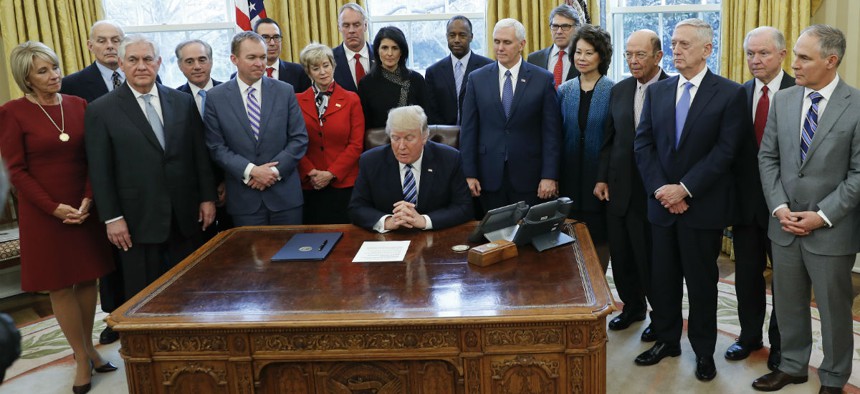
President Trump signs the reorganization executive order with members of his Cabinet looking on. Pablo Martinez Monsivais/AP
Ex-OMB Controller Praises Trump’s Agency Reorganization Plan
Mader likes "whole of government" view and 12-month lead time.
President Trump’s March 13 executive order on reorganizing government has some advantages over those offered during the Obama administration, in the view of former U.S. Controller David Mader.
The plan, which calls on agencies to take six months to scour around for inefficiencies and then report recommendations to the Office of Management and Budget, is a “really good approach” because it “looks at the breadth and complexity of this thing called government as opposed to picking a department here and a department there,” he told Government Executive.
Trump, in his executive order and budget blueprint, “is taking a whole-of-government view, while Obama picked a bunch of programs that were closely aligned and created a new department,” a plan “which, unfortunately, didn’t go anywhere,” said Mader, now chief strategy officer for the civilian sector of Deloitte Consulting LLP.
Trump’s team “did a good job highlighting the areas that the administration will focus on from a management perspective: the delivery of services to citizens but also the efficiency of mission-support services going forward, such as the back office operations and information technology,” Mader said.
The plan that OMB, after six more months of review, will submit to the president “will have everything on the table at one time, which will allow for a more effective discussion of the executive branch and the legislative branch,” Mader added, noting that some reforms will require legislation. “It’s all about trade-offs between what will be more effective and more efficient.”
The plan that emerges would address such questions as whether to merge agencies and expand shared services across government, as well as whether some programs could be devolved to states or localities or a combination of public and private-sector programs.
The Republican goal of shrinking the government “could make it more efficient and more effective,” he said, just as private-sector organizations downsize when the economy experiences a downturn. They ask “do we really want two financial systems, two human resources offices and two acquisition systems,” Mader said, “which allows them to find the right combination, whether it’s consolidation or shared services.”
Obama’s approach was “tightly focused around trade, and lots of different interests were brought to bear,” Mader said. Members of Congress tended to view such proposals in terms of how they would affect their state or district, especially when a single agency leader proposed reforms. “But now we will see across the government, with all the secretaries proposing a reorganization plan, Congress will have to look at it differently,” said Mader, who spent decades as a career federal executive (mostly at the Internal Revenue Service and OMB) and 11 years in the private sector.
Trump’s plan might also provide an opportunity, he said, for “career executives to put forward their own bold plans on how to make delivery of the mission better,” both from the taxpayer perspective and from the point of view of themselves as managers
What also struck him about the Trump plan “is its very specific requirement to get public input,” Mader said. “I don’t remember any previous administration doing that. In making government more efficient and effective, we don’t want people thinking there will be harm to services to citizens,” so that voice is important, Mader added, as are the best practices that come recommended from the private sector, states and foreign governments. A year to create the plan, he said, is “a long time.”







